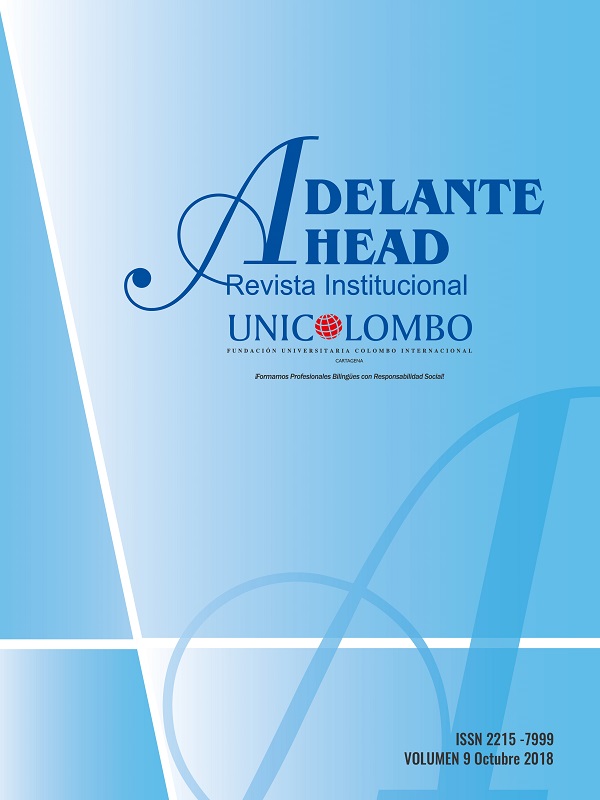CULTURE IN FOREIGN LANGUAGE TEACHING: A REVIEW
Resumen
Abstract: Language plays a crucial role not only in the construction of culture but also in the emergence of cultural changes. The possibility of changing the attitudes of people by giving them a new vocabulary to build social realities whether national, gender or racial realities that allow them to access to opportunities to develop and use language to communicate and create relationships. This article presents a literature review about the role of culture in teaching a foreign language taking into account some pedagogical and didactic aspects involved in the teaching process. As the main result, it is concluded that it is impossible to teach a language without teaching the culture; the teacher becomes a mediator between foreign languages and culture, that is why certain aspects of teaching can influence the inclusion or exclusion of that elements in a foreign language classroom.
Keywords: culture, foreign language teaching, intercultural teaching resources.
Resumen: El lenguaje juega un rol crucial en la construcción de la cultura, pero también en el surgimiento de los cambios culturales. La posibilidad de cambiar la actitud de las personas proporcionándoles un nuevo vocabulario para construir las realidades sociales, ya sean nacionales, de género o raciales que les permitan acceder a oportunidades para desarrollar y utilizar el lenguaje para comunicarse y crear relaciones. Este artículo presenta una revisión de literatura sobre el papel de la cultura en la enseñanza de una lengua extranjera, teniendo en cuenta algunos aspectos pedagógicos y didácticos involucrados en el proceso de enseñanza. Como resultado principal, se confirma que es imposible enseñar un idioma sin enseñar la cultura.; el profesor se convierte en un mediador entre las lenguas extranjeras y la cultura, es por ello que ciertos aspectos de la enseñanza pueden influir en la inclusión o exclusión de ese elemento en un aula de idiomas extranjeros.
Palabras claves: cultura, enseñanza de lenguas extranjeras, recursos de enseñanza intercultural.
Descargas
Citas
References
Ali, Sh., Kazemian, B. & Mahar, I. (2015). The Importance of Culture in Second and Foreign Language Learning. Dinamika Ilmu, (15)1. p. 1-10.
Arnedo, C., & Imitola, A. (2014). Guía de diseño de materiales para la enseñanza del inglés (tesis de pregrado). F u n d a c i ó n U n i ve r s i t a r i a C o l o m b o Internacional, Cartagena.
Assemi, A., Saleh, S., Asayeshh, M., Janfaza, E. & Abbassi,
G. (2012). International Conference on Language, Medias and Culture, IPEDR, N°33, p. 78-82.
Banegas, D. L. (2016). Teachers develop CLIL materials in Argentina: a workshop experience. Latin American Journal of Content and Language Integrated Learning, 9(1), 17-36.
Berardo, K., & Deardorff, D. K. (2012). Building Cultural Competence: Innovative Activities and Models. Sterling, Virginia: Stylus Publishing.
Bronfenbrenner, U. (1994). Ecology of the family as a context for human development: research perspectives. Developmental Psychology, 22(6), p.
-742.
Byram, M., & Feng, A. (2004). Culture and language learning: Teaching, research and scholarship. Language Teaching, 37(3), 149-168.
Byram, M., Gribkova, B. & Starkey, H. (2002). Developing the Intercultural Dimension in Language Teaching: a practical introduction for teachers. Language Policy Division, Directorate of School, Out-of- School and Higher Education, Council of Europe: Strasbourg.
Cakir, I. (2006). Developing Cultural Awareness in Foreign Language Teaching. Turkish Online Journal of Distance Education -TOJDE. 7(3), p. 154-161.
Carignan, N., Sanders, M. & Pourdavood, R. (2005). Racism and Ethnocentrism, International journal of Qualitative Methods, 4(3), p. 1.19.
Castillo, M. (2013). Narratives of place, belonging and language: An intercultural perspective. Colombian Applied Linguistic Journal, (15)2, p. 312-314.
Castro, C, & Alarcón, L. (2012). Retos pedagógicos y perspectivas teóricas de la educación intercultural en el Caribe colombiano. Memorias: Revista Digital de Historia y Arqueología desde el Caribe, (16), 69-101.
Cazden, C. (1988). Classroom Discourse. The Language of Teaching and Learning. New Hampshire: Heinemann Educational Books.
Clout, R. (2006). Between one's own culture and the target culture. The language teacher as intercultural mediator. Porta Linguarum: revista internacional de didáctica de las lenguas extranjeras, N°5, p. 53- 62.
Cummins, J. (2001). Negotiating identities: Education for empowerment in a diverse society. Los Ángeles, Estados Unidos: California Association for Bilingual Education.
Cruz, E. (2015). La interculturalidad en las políticas de
educación intercultural. Praxis & saber, 6(12),
-207.
Darling, N. (2007). Ecological Systems Theory: The Person in the Center of the Circles. Research in Human Development, (4)3-4, p. 203-217.
Deardorff, Darla K. (2009). The SAGE Handbook of Intercultural Competence. Thousand Oaks, CA: Sage publications Inc.
Ellis, R. (1994). The Study of Second Language Acquisition. US: OUP.
Espinosa, M. (2009). Lineamientos para la construcción de políticas públicas interculturales. Quito: Ecuador.
Fakirska, Y. (2010), Preparation of Pre-School Pedagogues to Work in a Multi-Cultural Environment, Quality Education for All Through Improving Teacher Training. International Journal of Global Education (2),1.
Freeman, D. & Johnson, K. (1998). Reconceptualizing the Knowledge-Base of Language Teacher Education. TESOL Quarterly, (32)3, p. 397-
Gao, F. (2006). Language is Culture – On Intercultural Communication. Journal of Language and Linguistics (5),1, p.58-67.
Genk, B. & Bada, E. (2005). Culture in Language Learning and Teaching. The reading Matrix, (5)1, p. 73- 84.
Hager, M. (2011). Culture, Psychology, and Language Learning. Oxford: Peter Lang AG.
Hamza, A. (2018). The role of Culture in Teaching and Learning English as a Foreign Language. Basic Education College Magazine for Educational and Humanities, N°38, p. 797-807
Hannerz, U. (1973). The Second Language: An Anthropological View. TESOL Quarterly, (7)3, p. 235-248.
Huertas, O., & Sánchez M. (2014). Educación intercultural, socioeconómica y construcción de ciudadanía en Colombia: el caso del distrito de santa marta. Economía Del Caribe, (14), p. 149-163.
Israelson, A. (2016). Teacher`s perceptions of the concept of intercultural competence in teaching English. Stockholms university.
Jaraba, D, & Arrieta, A. (2012). Etno English: trenzando palabras, historias y proyectos de vida del pueblo zenú. Íkala, Revista de Lenguaje y Cultura, 17(1), p. 95-104.
Kelly, P. (2006). What is Teacher Learning? A socio- cultural Perspective. Oxford Review of Education, 32(4), p. 505-519.
Kramsch, C. (2014). Language and Culture. AILA Review, N°27, p. 30-55.
__________ (2013). Teaching, Culture in foreign language. Iranian Journal of Language Teaching Research, 1(1), p. 57-78.
(2008). Ecological perspectives on foreign language education. Language Teaching, 41(3), 389-408.
__________ (1995). The cultural component of language teaching. Language, Culture and Curriculum, (8)2, p.83-92.
Kramsch, C. & Widdowson, H. (1998). Language and Culture. Oxford: Oxford University Press.
Kramsch, C. & Sullivan P. (1996). 'Appropriate pedagogy'.
ELT Journal, (50),3, p. 199-212.
Lemus, H. (2010). La educación intercultural en el contexto de la atención y educación de la primera infancia. Tesis de grado. Universidad tecnológica de Pereira.
Li, Y. (2016). Intercultural Awareness in Foreign Language Teaching: A Chinese Perspective. Journal of Language Teaching and Research. 7 (4), p. 768-772.
Liang, A. (2013). The Study of Second Language Acquisition Under Socio-Cultural Theory. American Journal of Educational Research, 1(5), p. 162-167.
Lickliter, R. (2000). An Ecological Approach to Behavioral Development: Insights from Comparative Psychology. Ecological Psychology, 12(4), p. 319-334.
Mohammadi, S. & Sadat, F. (2012). The Study of Culture on Foreign Language Teaching. International Journal of Social Science and Humanity, (2)6, p. 522-524.
Papa, I. (2015). Culture and Language as Factors Related in the Process of Learning and Education. European Journal of Language and Literature Studies, (1)1, p. 16-19.
Paraquett, M. (2009). O papel que cumprimos os professores de Espanhol como língua estrangeira (E/LE) no Brasil. Cadernos de Letras da UFF, 38, p. 123-137.
Peer, K. and McClendon, R. (2002). Socicultural Learning Theory in Practice: Implications for Athleitc Training Educators. Journal of Athletic Training, 37(4), p. 136-140.
Polly, D; Allman, B; Casto, A; & Norwood, J. (2017). Sociocultural Perspectives of Learning. In: Foundations of Learning and Instructional Design Technology Subtitle: Historical Roots and Current Trends, Richard West (Edt.). Quebec:
Pressbooks.
Rehaag, I. (2010). La perspectiva intercultural en la educación. El Cotidiano, 160, p. 75-83.
Sapir, E. (1921). Language an introduction to the study of speech.New york: Harcourt,Brace.
Savu, E. (2016). Intercultural Awareness in Teaching English as a Foreign Language. In: J. Buldea &
C. Sigmirean (Ed.) Multicultural Representations. Literature and Discourse as Forms of Dialogue. Tîrgu Mure : Arhipelag XXI Press
Seelye, N. H. (1984). Teaching culture: Strategies for intercultural communication. Lincolnwood, IL: National Textbook Company.
Soltis, J. (1984). On the nature of educational research.
Educational Researcher, (10)13, p.5-10.
Sun, L. (2013). Culture Teaching in Foreign Language Teaching. Theory and Practice in Language Studies, (3)2. p. 371-375.
Tang, R. (1999). The place of culture in the foreign language classroom: A reflection. The Internet TESL Journal, 8 (5). Retrieved from http://iteslj.org/Articles/Tang-Culture.html.
Tharp, B. ( 2012 . ) . Defining “ Culture” and “ O r g a n i z a t i o n a l C u l t u r e ” : F r o m Anthropology to the Office. Haworth, April 2009.
Trujillo, F. (2002). Towards Intercultural through Language Teaching: Argumentative discourse. Revista de Filología y su Didáctica CAUCE, (25),103-119.
Uddin, Rahim. (2014). The role of culture in teaching and learning of English as a foreign language. International Journal of Multidisciplinary Research, (1), 4.
Vygotsky, L. (1978). Mind in Society: Development of Higher Psychological Processes. Massachusetts: Harvard University Press.
Walsh, C. (2005). Interculturalidad, colonialidad y educación. Signo y pensamiento, (24)46, p.39-50.
Descargas
Publicado
Cómo citar
Número
Sección
Licencia
Derechos de autor 2019 Liz Ramirez, Vianny Mórelo Gómez, Vianny Mórelo Gómez.

Esta obra está bajo una licencia internacional Creative Commons Atribución 4.0.
Creative Commons Atribución/Reconocimiento-NoComercial-CompartirIgual 4.0 Licencia Pública Internacional — CC BY-NC-SA 4.0








